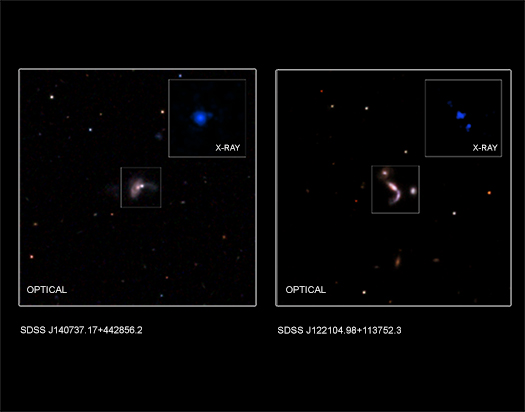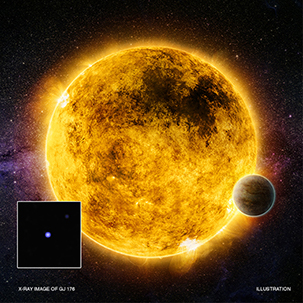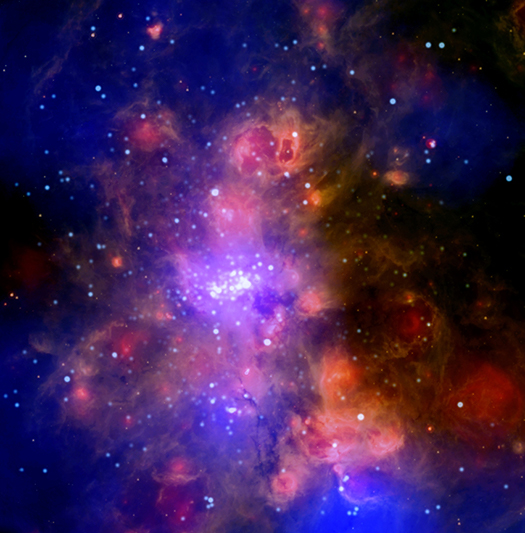Chandra Makes First Detection of X-rays from a Gravitational Wave Source: Interview with Chandra Scientist Wen-fai Fong
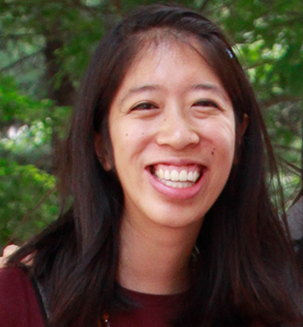
Chandra Scientist Wen-fai Fong
Originally from Rochester, NY, Wen-fai Fong received double Bachelor's degrees in Physics and Biology at the Massachusetts Institute of Technology, and earned her Ph.D. in Astronomy & Astrophysics from Harvard University. She was subsequently awarded an Einstein Postdoctoral Fellowship, which she took to the University of Arizona's Steward Observatory. She is currently a Hubble Postdoctoral Fellow at Northwestern University and will begin her appointment as Assistant Professor there in Fall 2018. Wen-fai is excited about unraveling the mysteries enshrouding cosmic explosions, including gamma-ray bursts and gravitational wave sources.
What are gravitational waves? What are neutron stars?
Gravitational waves are best described as ripples in space-time. To envision these merging compact objects, I always try to think of two round objects on a very flexible trampoline, rolling and rolling around each other. For the most flexible of trampolines, they will create some sort of pattern outward, while also spiraling toward each other and eventually colliding. It’s an oversimplified version, but that is how I best imagine what is going on.
In reality, the specific properties of the system — the masses, spins, orbital orientation, and distance — determine the very special pattern of the gravitational waves that are radiated from a system. Scientists then match that pattern against a gigantic bank of patterns by the gravitational wave experts who are able to determine very specific properties of the system. So it is a very neat and elegant problem that is made possible by many years of hard work.
Chandra Makes First Detection of X-rays from a Gravitational Wave Source: Interview with Chandra Scientist Raffaella Margutti

Chandra Scientist Raffaella Margutti
Raffaella Margutti obtained a PhD degree in Physics and Astronomy from the University of Milano Bicocca, Italy, in 2010, working on the broad-band (radio to gamma-ray) emission from relativistic jets in gamma-ray bursts within the Swift team. She then worked as a postdoctoral fellow at the Institute for Theory and Computation (ITC) at Harvard University, and then moved in 2015 for one year to New York University as James Arthur Fellow. Raffaella began a faculty position at Northwestern University (Physics and Astronomy) in 2016. She has been working in the field of Astronomical transients for more than a decade, with a wide range of expertise including, Stellar Explosions, Gamma-Ray bursts, Tidal Disruption Events, Stellar Outburst, and now, counterparts to GW.
What are gravitational waves?
Gravitational Waves are ripples in space-time that become particularly strong when very violent event in our Universe happen, like the merge of two very peculiar stars that we call neutron stars (NS). NS are what get left behind after a big star like 10 times the Sun ends its life with a big explosion.
Chandra Makes First Detection of X-rays from a Gravitational Wave Source: Interview with Chandra Scientist Eleonora Nora Troja

Chandra Scientist Eleonora Nora Troja
Eleonora Nora Troja was born and raised in Palermo, Sicily. After completing her PhD at the University of Palermo, she moved to NASA Goddard Space Flight Center as a NASA Postdoctoral Program Fellow. Her main research interest is the study of gamma-ray bursts, and in particular the connection between short duration gamma-ray bursts, neutron star mergers and gravitational waves. Beside her studies, she also leads the Swift Guest Investigator Program and serves as co-chair for the Athena mission working groups.
What are gravitational waves?
Gravitational waves are ripples in the fabric of space and time. According to Einstein’s theory of general relativity, every moving object actually emits a tiny amount of gravitational waves, but the signal is usually too small for us to detect. In order for us to detect gravitational waves, we need to wait for catastrophic events like the collision of two neutron stars. This brings to the second question, what are neutron stars? Neutron stars are some of the most exotic and dense objects in our Universe. These stars weight as much as our Sun but they are much smaller in size. A neutron star can extend up to 15-17 miles across, this is more or less the size of Washington D.C.
Seeing Double: Scientists Find Elusive Giant Black Hole Pairs
This graphic shows two of five new pairs of supermassive black holes recently identified by astronomers using a combination of data from NASA's Chandra X-ray Observatory, the Wide-Field Infrared Sky Explorer Survey (WISE), the ground-based Large Binocular Telescope in Arizona, and the Sloan Digital Sky Survey (SDSS) Mapping Nearby Galaxies at APO (MaNGA) survey. This discovery could help astronomers better understand how giant black holes grow and how they may produce the strongest gravitational wave signals in the Universe, as described in our press release.
Each pair contains two supermassive black holes weighing millions of times the mass of the Sun. These black hole couples formed when two galaxies collided and merged with each other, forcing their supermassive black holes close together. While theoretical models have predicted such giant growing black hole pairings should be relatively abundant, they have been difficult to find.
Two Stars, Three Dimensions, and Oodles of Energy
For decades, astronomers have known about irregular outbursts from the double star system V745 Sco, which is located about 25,000 light years from Earth. Astronomers were caught by surprise when previous outbursts from this system were seen in 1937 and 1989. When the system erupted on February 6, 2014, however, scientists were ready to observe the event with a suite of telescopes including NASA’s Chandra X-ray Observatory.
V745 Sco is a binary star system that consists of a red giant star and a white dwarf locked together by gravity. These two stellar objects orbit so closely around one another that the outer layers of the red giant are pulled away by the intense gravitational force of the white dwarf. This material gradually falls onto the surface of the white dwarf. Over time, enough material may accumulate on the white dwarf to trigger a colossal thermonuclear explosion, causing a dramatic brightening of the binary called a nova. Astronomers saw V745 Sco fade by a factor of a thousand in optical light over the course of about 9 days.
X-rays Reveal Temperament of Possible Planet-hosting Stars
A new study using data from NASA's Chandra X-ray Observatory and ESA's XMM-Newton suggests X-rays emitted by a planet's host star may provide critical clues to just how hospitable a star system could be. A team of researchers looked at 24 stars similar to the Sun, each at least one billion years old, and how their X-ray brightness changed over time.
Since stellar X-rays mirror magnetic activity, X-ray observations can tell astronomers about the high-energy environment around the star. In the new study the X-ray data from Chandra and XMM-Newton revealed that stars like the Sun and their less massive cousins calm down surprisingly quickly after a turbulent youth.
This artist's illustration depicts one of these comparatively calm, older Sun-like stars with a planet in orbit around it. The large dark area is a "coronal hole", a phenomenon associated with low levels of magnetic activity. The inset box shows the Chandra data of one of the observed objects, a two billion year old star called GJ 176, located 30 light years from Earth.
What Chandra & X-ray Astronomy Give Back
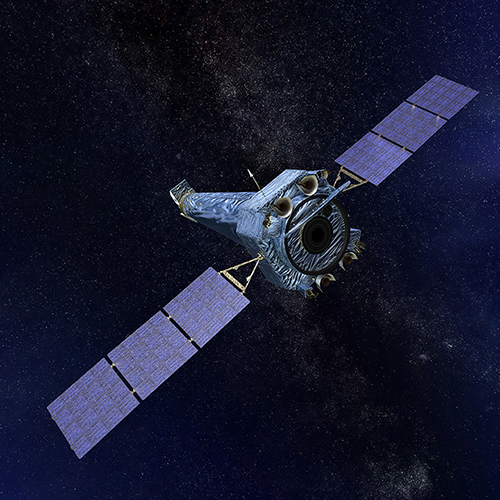
Illustration of Chandra X-ray Observatory
This week marks the 18th anniversary of Chandra’s “First Light,” when the first publicly available images from NASA’s flagship X-ray mission were released back in 1999 . Week after week, month after month, year after year, Chandra continues to deliver amazing results and make truly extraordinary discoveries across space. Scientists know so much more about the Universe now than we did before this amazing telescope began its work.
IC 10: A Starburst Galaxy with the Prospect of Gravitational Waves
In 1887, American astronomer Lewis Swift discovered a glowing cloud, or nebula, that turned out to be a small galaxy about 2.2 million light years from Earth. Today, it is known as the "starburst" galaxy IC 10, referring to the intense star formation activity occurring there.
More than a hundred years after Swift's discovery, astronomers are studying IC 10 with the most powerful telescopes of the 21st century. New observations with NASA's Chandra X-ray Observatory reveal many pairs of stars that may one day become sources of perhaps the most exciting cosmic phenomenon observed in recent years: gravitational waves.
Pathways to the Stars -- II

Jeff McClintock
(A continuing series on how astrophysicists’ varied career paths. Pathways to the Stars -- I) Jeff's Journey
Jeff McClintock is recognized around the world as one the pre-eminent experts on black holes. In 2009, he shared the American Astronomical Society’s prestigious Bruno Rossi prize, along with Ron Remillard and Charles Bailyn for his work on the measurement of the masses of black holes.
McClintock has also served on the board of directors for the Giant Magellan Telescope, a telescope under construction that when it is commissioned in 2022, will be the largest optical telescope in existence. As it turns out, Jeff has been interested in large telescopes for a long time, going back to his childhood in Port Orchard, Washington.
“I saw an ad in Popular Mechanics,” he remembered. “It said, ‘You can build a 100-power telescope for $1!’”
McClintock mailed in his dollar, and received two lenses in the mail.
“That was it. Two lenses. I inserted the lenses at the ends of a discarded 8-foot cardboard tube which had been used to store linoleum."
He didn’t have a mount for his telescope, so he put it on several chairs in the living room, and looked through it, at some lights across Port Orchard strait near Seattle.
“I could see blue lights across the bay, and read a sign. It was upside down! I took it up to the attic and looked at the moon. I was blown away!”
Inspired by the view of the craters on the moon, McClintock built a second telescope, a 6” reflector.
W51: Chandra Peers into a Nurturing Cloud
In the context of space, the term 'cloud' can mean something rather different from the fluffy white collections of water in the sky or a way to store data or process information. Giant molecular clouds are vast cosmic objects, composed primarily of hydrogen molecules and helium atoms, where new stars and planets are born. These clouds can contain more mass than a million suns, and stretch across hundreds of light years.
The giant molecular cloud known as W51 is one of the closest to Earth at a distance of about 17,000 light years. Because of its relative proximity, W51 provides astronomers with an excellent opportunity to study how stars are forming in our Milky Way galaxy.
A new composite image of W51 shows the high-energy output from this stellar nursery, where X-rays from Chandra are colored blue. In about 20 hours of Chandra exposure time, over 600 young stars were detected as point-like X-ray sources, and diffuse X-ray emission from interstellar gas with a temperature of a million degrees or more was also observed. Infrared light observed with NASA's Spitzer Space Telescope appears orange and yellow-green and shows cool gas and stars surrounded by disks of cool material.

